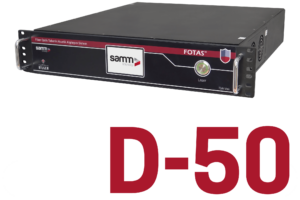Fiber Optics is a sub-field of optics. While optics is the field of light, fiber optics is concerned with the optical phenomenon in glass fibers only. Fiber means threads and when we called fiber optics it refers to the glass threads that enable the light to pass through. All the physical phenomena of telecommunication matters include fiber optics. Today most of the internet is based on fiber optic cables. They are the descendants of the copper electrical cables, but if there are electrical cables already, why do we use fiber optic cables instead?
Previous standard telecommunication cables are made of copper or other conductor metals. These cables carry electrons from one end to the other end. With help of other devices, these running current carries valuable data. Former telephone lines and then internet lines were made of these types of cables.
Then new technologies took the place of these old cables. Fiber optic technology comes into the game at that point. While the transferred data gets bigger, electric current-based cables fail to function. In 1990 total internet users are 2.6 million people while in 2016 this number multiplied by 1310 and gets to 3.406 billion people. So far you have noticed that the conventional electric cables cannot handle the data and are replaced by the new technology which is Fiber Optics.
Fiber optic cables can transmit greater data than copper cables. In fact, this speed difference is approximately on the order of 10 times to 1000 times. This capacity difference in speed puts fiber optics forward, but it doesn’t stop there. Fiber optics are better than copper cables in many ways like mininmum data loss, data transfer at the speed of light, very light but durable cables for outdoor transfer, immunity to electromagnetic interference etc. If we to emphasize one of them, it would be the carrying capacities. The other would be costs. For the understanding of the cost, let’s look at Fig01 to see what fiber optic cables are made of
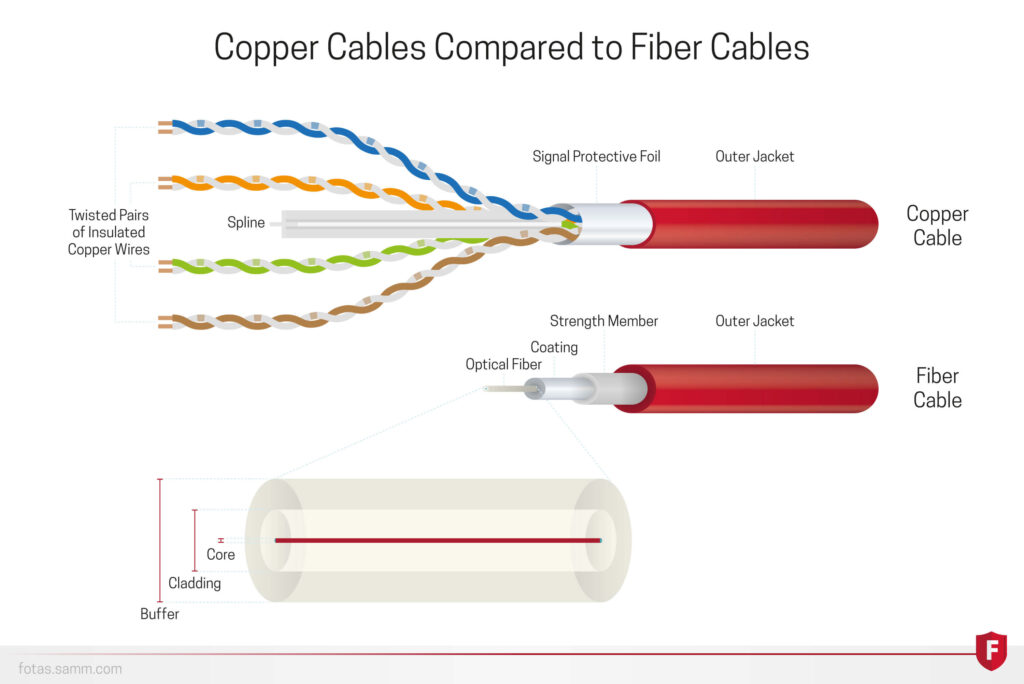
The main component of fiber optic cable is optical fiber. Optical fibers are made of glass or some similar materials. The purpose of this fiber is to carry the light (photons). Hence the material should be transparent. This carried light in the fiber optic cable is generated through laser devices. In addition to being transparent, materials should be durable, flexible, cheap, and easy to produce. Glass is surprisingly flexible at 9 micrometers diameter. Then it should be viable. Optical fibers are cheap because humans have thousands of years of experience with glass in terms of both industrial and craftsmanship-wise. Through this experience, fiber optics are produced. A chunk of glass material which is hung to the high places and through receiving some processing, glass gets thinner and thinner. The core of it becomes 9 micrometers with this process. Fiber Optic Cable does not consist of only the “core”, which is the glass part. but the light is propagating through the core without any protection. Also light scatters in random directions. Light needs a “wave-guide” and protected layers to reach the target location with minimum data loss. For making a wave-guide, the core is coated with some material. This coating is called “Cladding”.
This cladding’s refractive index is lower than the core. It makes light propagate inside the core. Then some protecting layer is applied on top of the cladding layer, which is called “Coating”. For special uses, the cable can be coated with many different materials, including materials for UV protection and radiation protection. With these protective coatings, fiber optic cables can be used anywhere including underground transatlantic telecommunications.
Light (photon) travels inside the core and as it goes along it bounces fiber walls. The design of the fiber optic cables is to make the light rays unable to propagate outwards. Nevertheless, some of them propagate out of the cable. This phenomenon is called optical loss. In contrast to this, the physical law that makes light bounce and stay inside the cable is Snell’s Law.When light stays inside the cable without loss while bouncing is a phenomenon called Total Internal Reflection.
The word Laser is an acronym for Light Amplification by Stimulated Emission of Radiation. DAS systems and many other systems use Laser technologies. The FOTAS system uses laser light to obtain intrusion data. As mentioned in the OTDR post, laser light travels across the fiber optic cable and scatters inside the cable. These scattered lights are collected by the OTDR unit.
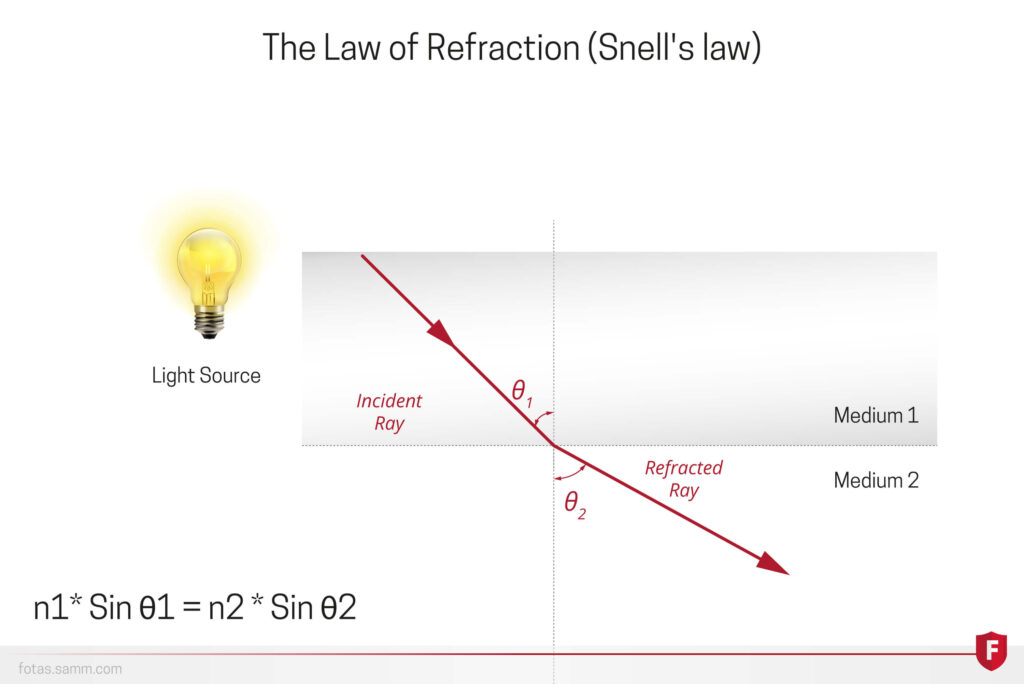
The laser can seem to be a standard light source, but the reality is far from this. Laser light is a special kind of light. Why? First of all laser light is collimated. It means that all the laser lights are parallel to each other and unidirectional. They all go in the same direction and do not cross each other on the path. In this way the light does not lose any of the power that wants to be delivered to the target location. If you want to illuminate a small area or spot you cannot use a light bulb or LED light alone, because the light coming out of these devices diverge over large distances. The same thing also happens with the laser light too but the ratio of it in laser compared to the other light sources is minuscule. This divergence rate is also the basis for the length of the fiber optic cable. With this minuscule rate of divergence, power can be transferred over large distances without significant loss.
The other specialty is a multi-purpose feature of laser light which is coherence. Laser light is a coherent light which means the photons of the laser have the same phase, direction, and polarization. These advantages make lasers very useful. They make laser printers work or Cd-Dvd readers-writers work. Also, the equality of phases makes Phase-OTDR’s and the FOTAS work properly.

We briefly explained the direction phenomena. Now let’s explain what phase and phase differences means. Phase word means “appearance” in Greek. Hence phase difference means appearance difference. If there is a phase difference between waves, they appear differently because one of them is going ahead or behind. The useful effect of the equal phase is again energy delivery. You can think of this like hammering a nail but hitting it with a very low force. It won’t nail but if you add the hitting forces together and hit it with that combined force, it will definitely nail. The same principle applies to lasers. It is not possible to remove tattoo with LED or to cut steel with a standard light bulb; but all these works can be done with a laser.
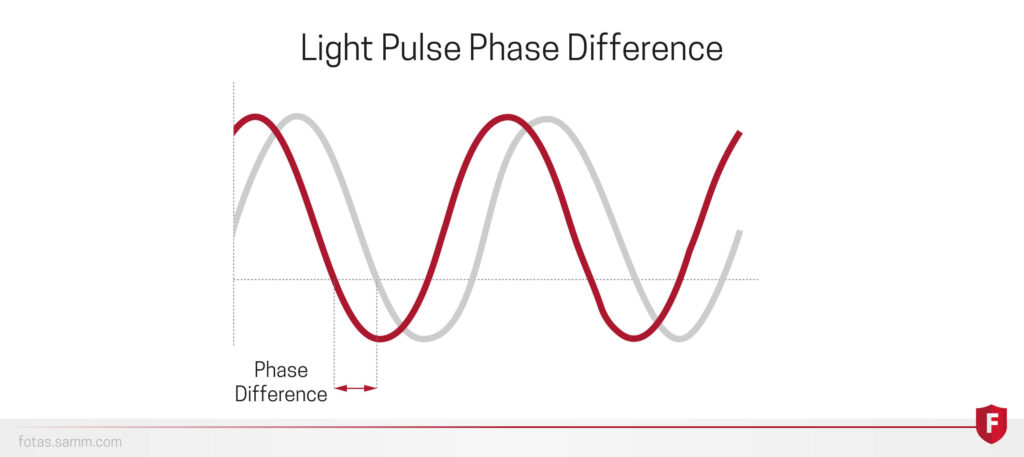
We have talked about the same direction and power delivery; but what about the polarization? When we say polarization, we mean that a wave’s oscillations have a definite direction relative to the direction of propagation of the wave. EM waves are transverse waves consisting of varying electric and magnetic fields that oscillate perpendicular to the direction of propagation (see Figure 2). There are specific directions for the oscillations of the electric and magnetic fields. Waves having such a direction are said to be polarized. For an EM wave, we define the direction of polarization to be the direction parallel to the electric field. Thus we can think of the electric field arrows as showing the direction of polarization, as in Figure 2. Light is also an electro-magnetic wave which means it carries electric and magnetic fields.
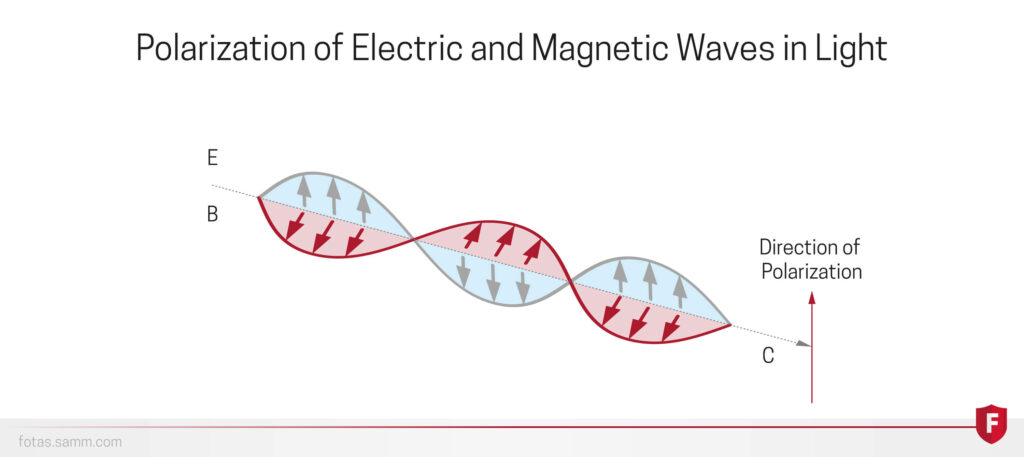
It may be parallel or perpendicular. The daily usage of polarization is 3d glasses. If you turn your head in z rotation while wearing 3d glasses, you can see the difference while watching a movie. It will be brighter when your head is perpendicular to the floor, and it will be darker when it is parallel.
Lasers work based on the stimulated emission. What is stimulated emission? The answer lies in the atom. Atoms have different energy levels for their electrons. These levels are quantized which means levels are at discrete values. The electrons are present in some energy levels and other levels are empty. The electrons tend to stay in lower energy levels, but when they absorb energy, they go to higher levels. Then they tend to emit this extra energy and move to the lower levels; since the higher energy levels are not energetically stable. Most of the time this process happens spontaneously. It’s called spontaneous emission. In lasers, this emission is controlled by some methods and the aim is to make all the emissions stimulated. When a photon is absorbed by an already excited electron, the electron emits two identical photons. Then these photons are absorbed by other electrons and those electrons emit many more photons. It’s the very basics of how the laser works.
Distributed Acoustic Sensing (DAS) is a type of technology that can detect acoustic signals.
The force going through the materials causes pressure replacements in the medium it travels; i.e. air, earth, water etc… We call these replacement phenomena acoustic waves. Sound waves are the most common example of acoustic waves.
Single point sensors are detecting devices that get signals at only one place. There is only one detection point such as the tip of the needle. On the contrary, in distributed sensors, these sensors or sensor-like structures are continuous. FOTAS uses fiber optic cables for distributed acoustic sensing. Most of the time, DAS systems use fiber optic cables. Light waves propagate in the fiber optic cable are affected by acoustic waves. These affected lights can be detected by various devices, such as Optical Time Domain Reflectometry (OTDR).
Distributed Acoustic Sensing (DAS) is a type of technology that can detect acoustic signals.
The force going through the materials causes pressure replacements in the medium it travels; i.e. air, earth, water etc… We call these replacement phenomena acoustic waves. Sound waves are the most common example of acoustic waves.
Single point sensors are detecting devices that get signals at only one place. There is only one detection point such as the tip of the needle. On the contrary, in distributed sensors, these sensors or sensor-like structures are continuous. FOTAS uses fiber optic cables for distributed acoustic sensing. Most of the time, DAS systems use fiber optic cables. Light waves propagate in the fiber optic cable are affected by acoustic waves. These affected lights can be detected by various devices, such as Optical Time Domain Reflectometry (OTDR).
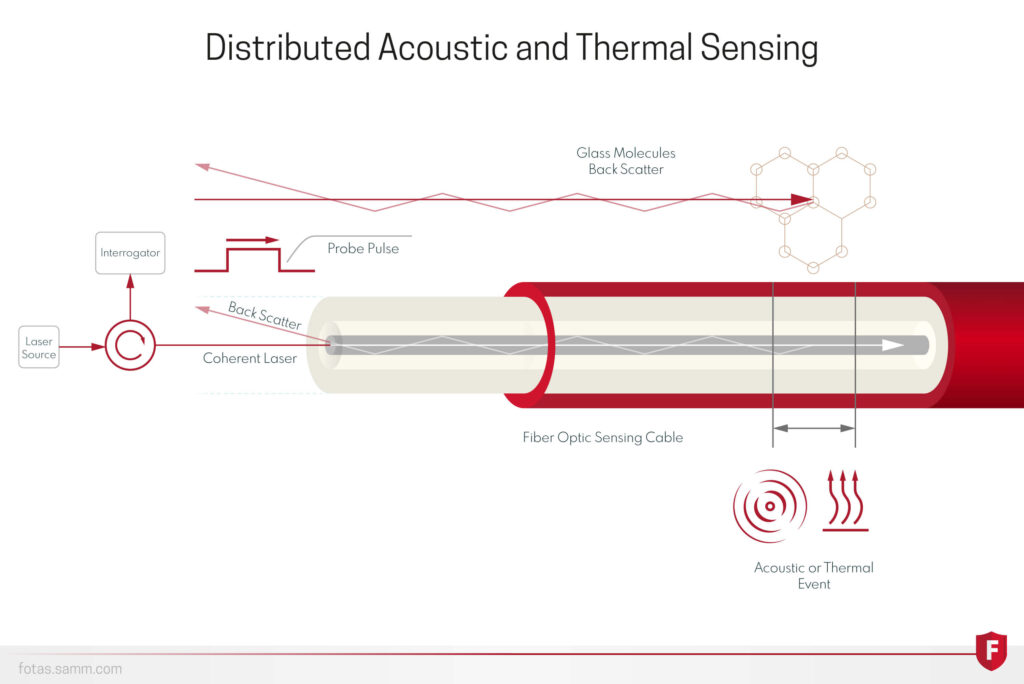
Distributed acoustic sensing technology refers to a system that includes optoelectronic products which can perform real-time control and measurement through fiber optic cables extending across the targeted borders. The most basic way to comprehend FOTAS technology is to imagine yourself on a treadmill. It is assumed that as you move against the direction of a treadmill, the sound waves will spread around. Those who are at a certain distance from there can understand that there is someone on the treadmill through real-time monitoring even they aren’t in the same room.
Throughout the aforementioned process, acoustic signals are measured by distributed acoustic sensors at each point of the fiber cable. Unlike sensors that measure at determining fixed points, fiber cable is used as a sensor in the DAS system. In other words, distributed acoustic sensor system turns fiber cable into microphones.
Optical Time Domain Reflectometry is a device that measures many features in fiber optic cables. They are mostly used to measure cable conditions and problems. If there are any transmission-related problems in fiber optic cables, OTDR can find them. OTDR’s common use is finding the break locations in fiber optic cables. These cables can carry data approximately a hundred kilometers before amplification. Hence if there is a break, the one who is going to repair the cable should examine every point on the cable over very long distances. Examining the cable over a hundred kilometers by hand is nearly impossible. There must be a device that examines the fiber optic cable from afar, which is the purpose of OTDR.
OTDR (Optical Time Domain Reflectometry) is a device used for the characterization of fiber optics. OTDR measures time and location, also called the domain. It sends light pulses and measures backscattered light amplitude. From the time difference, OTDR can calculate the fiber length and from the amplitude loss OTDR measures general losses, breaking points, and other effects on the fiber optic cable. Backscattered light’s amplitude always declines through the fiber optic cable. This is because of the impurities and light-particle interaction in the fiber optics. By this declining amplitude, OTDR can determine the loss coefficient. It is similar to running electric current encounters with resistance. This working principle helps us to determine if the fiber is broken or under any other loss-causing effect.
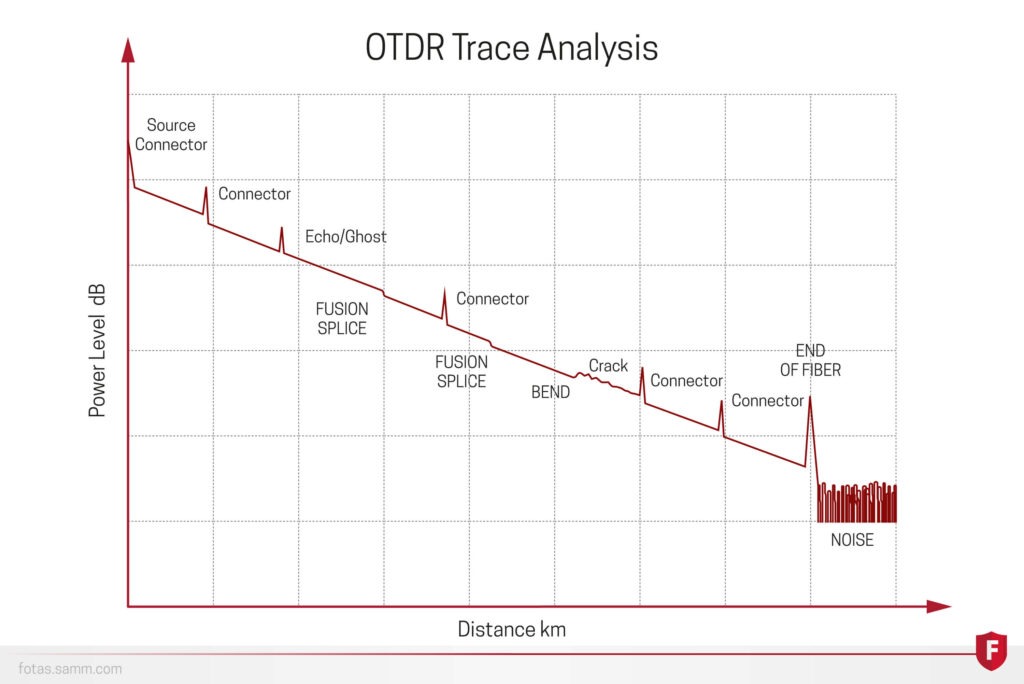
In the figure VIAVI MTS 2000 is presented. You can see two covers to the top of the OTDR. The one is for multi-mode fiber optic cables and the other is for single-mode fiber optic cables. The one should connect their cable to the correct port for the right measurements. Different cables may use different wavelengths.
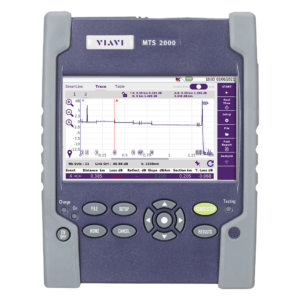
After connecting the fiber optic cable, OTDR sends a laser pulse into the cable.The laser pulse travels through the cable and scatters the backward. The device measures backscattered laser pulses characteristics such as the amplitude. The amplitude tends to decline all the time. The further you measure the amplitude in the cable, the weaker the amplitude of the scattered light gets. This is because while light is going through the fiber optic cable it gets a power loss. OTDR measures this power loss from the amplitude values. It also measures and saves the time difference so that we can understand the location and diagnose the problem. Some of the things OTDR is used to detect are as follows:
- Fiber Break
- Fiber Bending
- Splice Loss
- Connector Loss
- Patch Panel Locations
- Reflectance




